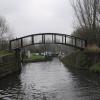
Mooring here is impossible (it may be physically impossible, forbidden, or allowed only for specific short-term purposes).
There is a bridge here which takes pedestrian traffic over the canal.
| Memory Lane Wharf | 5¾ furlongs | |
| Limekiln Lock No 43 | 5½ furlongs | |
| Belgrave Circle Arm (disused) | 4¾ furlongs | |
| Abbey Park Road Bridge No 9 | 4¾ furlongs | |
| Wolsey Chimneys | 1¼ furlongs | |
| Swan's Nest Bridge No 10 | ||
| Belgrave Lock No 44 | ¼ furlongs | |
| Holden Street Bridge No 11 | 1½ furlongs | |
| Thurcaston Footbridge | 4¾ furlongs | |
| Thurcaston Old Bridge No 12 | 4¾ furlongs | |
| Entrance to Riverside Lakes | 5¾ furlongs | |
- Grand Union Canal Walk — associated with Grand Union Canal
- An illustrated walk along the Grand Union Canal from London to Birmingham
Mouseover for more information or show routes to facility
Nearest water point
In the direction of Trent Junction
In the direction of River Soar Junction
Nearest rubbish disposal
In the direction of Trent Junction
In the direction of River Soar Junction
Nearest chemical toilet disposal
In the direction of Trent Junction
In the direction of River Soar Junction
Nearest place to turn
In the direction of Trent Junction
In the direction of River Soar Junction
Nearest self-operated pump-out
In the direction of River Soar Junction
Nearest boatyard pump-out
In the direction of Trent Junction
Wikipedia has a page about Swan's Nest Bridge
Swans are birds of the family Anatidae within the genus Cygnus. The swans' closest relatives include the geese and ducks. Swans are grouped with the closely related geese in the subfamily Anserinae where they form the tribe Cygnini. Sometimes, they are considered a distinct subfamily, Cygninae. There are six living and many extinct species of swan; in addition, there is a species known as the coscoroba swan which is no longer considered one of the true swans. Swans usually mate for life, although divorce sometimes occurs, particularly following nesting failure, and if a mate dies, the remaining swan will take up with another. The number of eggs in each clutch ranges from three to eight.










![Destroyed boardwalk leading to Ross Walk in Belgrave. This boardwalk used to run between Ross Walk and the Swans Nest Footbridge, it was recently destroyed in a fire.[[3757610]] by Mat Fascione – 07 February 2016](https://s0.geograph.org.uk/geophotos/04/82/56/4825624_a75d0a60_120x120.jpg)





![River Soar, Belgrave, Leicester. The Grand Union Canal joins the River Soar at this lock. The footbridge over the canal also straddles the grid line. Just out of shot on the right is a large shallow weir which is in [[SK5806]] by Kate Jewell – 25 October 2005](https://s3.geograph.org.uk/photos/07/02/070275_da4c2fde_120x120.jpg)


![Heavy flooding at Belgrave Lock. This is the point where the River Soar rejoins the Grand Union Canal. For a similar view with normal water levels [[2821902]] by Mat Fascione – 25 November 2012](https://s3.geograph.org.uk/geophotos/03/25/38/3253819_6413ffcf_120x120.jpg)











